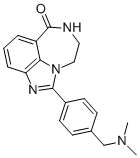All AbMole products are for research use only, cannot be used for human consumption.

AG14361 is a novel poly (ADP-ribose) polymerase-1 inhibitor with a GI50 of 10.9 µM. AG14361 enhances temozolomide activity in all MMR-proficient cells (1.5–3.3-fold) but is more effective in MMR-deficient cells (3.7–5.2-fold potentiation), overcoming temozolomide resistance. AG14361 significantly potentiated camptothecin-mediated cytotoxicity in all cells, except the base excision repair–deficient EM9 cells. In the breast cancer cell lines, AG14361 had no effect on IR-induced degradation of IkappaBalpha or nuclear translocation of p50 or p65. However, AG14361 inhibited IR-induced NF-kappaB-dependent transcription of a luciferase reporter gene.
| Cell Experiment | |
|---|---|
| Cell lines | LoVo, A549, and SW620 cells |
| Preparation method | Cell growth inhibition was estimated in exponentially growing LoVo, A549, and SW620 cells in 96-well plates. Cells were exposed to temozolomide (0–1000 μM, see Fig. 4, A) or topotecan (0–30 nM, see Fig. 4, B) in the presence or absence of 0.4 μM AG14361. Cells were also exposed to AG14361 (0–20 μM, see Fig. 4, C) alone or in the presence of 400 μM temozolomide. After 5 days of culture, these cells were fixed with 10% trichloroacetic acid and stained with sulforhodamine B (28). The concentration of temozolomide, topotecan, and AG14361 alone or in combination that inhibited growth by 50% (GI50) was calculated from computer-generated curves. |
| Concentrations | 0–20 μM |
| Incubation time | 5 days |
| Animal Experiment | |
|---|---|
| Animal models | CD-1 nude mice bearing palpable, subcutaneous SW620 or LoVo xenografts |
| Formulation | saline |
| Dosages | 5 or 15 mg/kg daily for 5 days |
| Administration | intraperitoneally |
| Molecular Weight | 320.39 |
| Formula | C19H20N4O |
| CAS Number | 328543-09-5 |
| Solubility (25°C) | DMSO ≥12 mg/mL |
| Storage |
Powder -20°C 3 years ; 4°C 2 years In solvent -80°C 6 months ; -20°C 1 month |
| Related PARP Products |
|---|
| 2-Methylquinazolin-4-ol
2-Methylquinazolin-4-ol is a potent competitive poly(ADP-ribose) synthetase inhibitor, with a Ki of 1.1 μM. 2-Methylquinazolin-4-ol mammalian aspartate transcarbamylase (ATCase) inhibitor, with IC50 of 0.20 mM. |
| DPQ
DPQ is a potent PARP-1 inhibitor. |
| OUL232
OUL232 is a potent inhibitor of mono-ARTs PARP7, PARP10, PARP11, PARP12, PARP14, and PARP15. |
| AZ3391
AZ3391 is a potent inhibitor of PARP. |
| PARP1-IN-5
PARP1-IN-5 is a low toxicity, orally active, potent and selective PARP-1 inhibitor (IC50 =14.7 nM). |
All AbMole products are for research use only, cannot be used for human consumption or veterinary use. We do not provide products or services to individuals. Please comply with the intended use and do not use AbMole products for any other purpose.


Products are for research use only. Not for human use. We do not sell to patients.
© Copyright 2010-2024 AbMole BioScience. All Rights Reserved.
